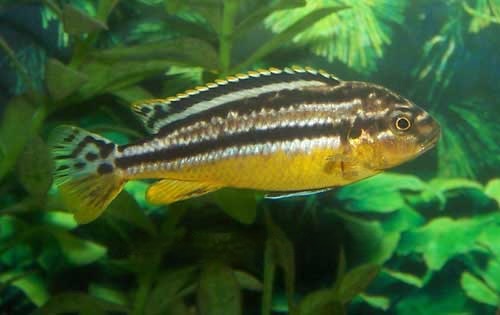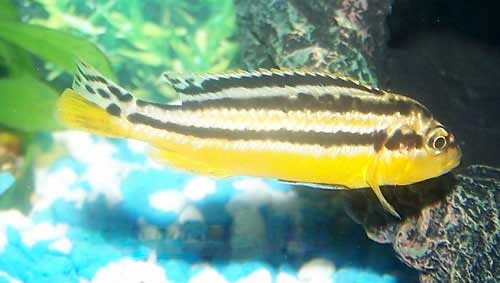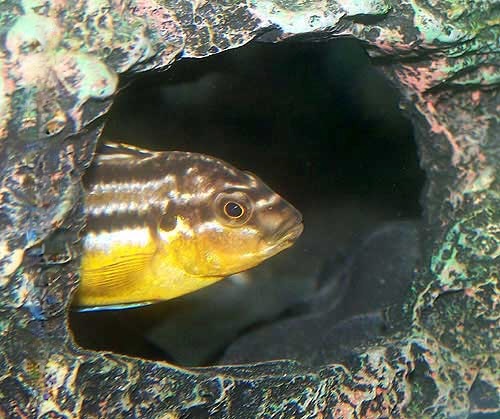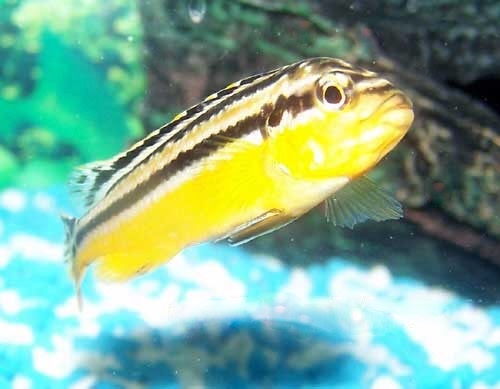Auratus - Yellow Coloring

Young Male Auratus turning brown
The Auratus originates from the rocky depths of Lake Malawi. The term auratus means yellow or golden. The Auratus is an mbuna or rockfish. It is also known as the Golden Mbuna and the Malawi Golden Cichlid. The scientific name was previously Pseudotropheus auratus. The females have the brighter coloration, which is a rarity in the fish world. Females are yellow with three dark parallel stripes fringed in white.
Auratus - Aggressive Males
Auratus males are black or brown and have a yellow / white stripe running through the mid line of their body. When they are young, the males look like females, which helps them survive the aggression of adult males. This fish can apparently change its sex when conditions dictate an imbalance in breeding partners. Auratus are very aggressive. Not only will a male auratus attack and kill other males, but females are known to kill each other as well. One male and 3 - 5 females are recommended for a tank.

Auratus
Auratus - Aquarium Setup
Auratus should be part of a large tank of 75 gallons or more that has caves, hiding areas and other species of mbuna. Live plants will be destroyed. A gravel substrate should be provided, but sharp material should be avoided, as mbunas will filter substrate through their mouths. Frequent water changes and multiple types of filtration are suggested.
Auratus - Feeding
The Auratus lives mainly on algae, so a quality spirulina flake food should be provided. Vegetable matter, plants, pellets and freeze dried foods can also be provided. It is best to avoid live foods as these can induce bloating in mbunas, which can be fatal.
Auratus - Compatibility
The Auratus or Golden Mbuna is compatible with other Mbuna Cichlids such as the Cobalt Blue, Electric Yellow Lab, Johanni, Lemon Yellow, Pindani, Red Zebra, Tropheops, and Kenyi. Auratus will also get along with synodontis catfish.
The Auratus is too aggressive for Haplochromis and Peacock Cichlids. Other fairly aggressive unrelated species such as New World cichlids and barbs, may be ignored.
Auratus - No Underground Filters
Although some recommend using underground filters, external filters and bio-wheels simultaneously to maintain quality, our experience is that underground filters are not suitable for mbunas. They build nests by picking up rocks in their mouth and moving them, so underground filters are quickly exposed in an mbuna tank.

Auratus like Caves
Auratus - Mouth Brooders
Auratus are mouth brooders. They tend to be more aggressive at the higher end of their temperature range and this can induce breeding. Increased aggression and digging in the substrate are both indications of impending spawning. Upon fertilization, the female takes the eggs in her mouth for hatching. Auratus are excellent parents and can raise their young in the same tank with other mbunas. The young can take sanctuary in the female's mouth for up to a month after hatching. The Auratus female will rarely eat while she is raising young.

Auratus or Golden Mbuna
Dither Fish for Auratus
Although danios, barbs and rainbowfish are sometimes suggested as dither fish to draw cichlids from hiding or target fish for reducing aggression among cichlids, we don't recommend that these species be subjected to the aggression of cichlids.
Auratus - Profile
-
Scientific Name: Melanochromis auratus
-
Family: Cichlid
-
Temperature: 22 - 28 C; 72 - 83 F
-
pH: 7.5 - 8.5
-
Size: 12 cm; 5 inches
-
Life Span: 10 years
-
Breeding: Normal, Egg Layer, Mouthbrooder